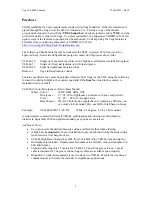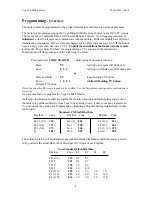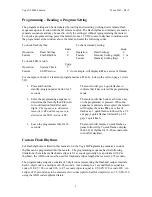
Vega VLB-44 Lantern
25 Jan 2011 - Rev 9
Custom Flash Rhythm
(cont’d)
First, determine the desired flash and eclipse lengths for your custom rhythm. Remember, as
discussed earlier in this manual, rotating beacons have very short flash lengths. The minimum
flash length for the VLB-44 is 0.3 seconds on minor aids. For major aids, a practical minimum
flash length is 0.5-1.0 seconds. Try to achieve around 10% duty cycle when assembling a flash
rhythm (period is the sum of the on times divided by the period; example: a FLW(2)15 with 1
second flashes has a duty cycle of 2/15x100=13.3%).
As an example, a fictitious light with a FL(2)W20 might have an existing rhythm of 0.1s FL, 4.9s
EC, 0.1s FL, 14.9s EC. A suitable replacement using the VLB-44 would be a 1s FL, 4s EC, 1s
FL, 14s EC. The mariner still sees 2 flashes every 20 seconds, the flash is longer providing a
better bearing and the duty cycle is at the desired 10% (2/20x100=10%). Now that you know the
flash and eclipse lengths, determine the programming codes.
•
The code for a custom rhythm is
2
. This is the first entry when programming the lantern;
•
For the 1 second flash, the code is 1/0.05=20 or
020
;
•
For the 4 second eclipse, the code is 4/0.05=80 or
080;
•
The 14 second eclipse exceeds the 12.75 second limitation, so it is entered as two 7
second codes: 7/0.05=
140
. The ADD code is
001;
•
000
is the termination code to tell the VLB-44 that the programming sequence has ended.
The sequence of codes mimics the flash rhythm. In this example the code sequence is:
2
start sequence for entering a custom rhythm
020
1 sec flash
080
4 sec eclipse
020
1 sec flash
140
7 sec eclipse
001
ADD code
140
7 sec eclipse (total eclipse -14 seconds)
000
termination code
With power applied to the lantern in a lighted room or outside, aim the remote at the window
above the label and:
1.
Press and hold the
standby/program/power button for 5
seconds.
2.
Enter the programming sequence for
the new flash rhythm listed above.
Do not pause more than 5 seconds
between codes. (wait for
confirmation flash after each digit)
3.
Leave the programmer idle for 10 sec
to exit the programming mode.
The lantern will give 4 quick flashes to
indicate that it has entered the programming
mode.
The lantern will flash once each time a key
on the programmer is pressed.
The light will give 3 long flashes to indicate
code has been accepted and then 2 quick
flashes, a pause followed by 2 quick flashes.
The lantern will display the previously
programmed flash rhythm.
10


















